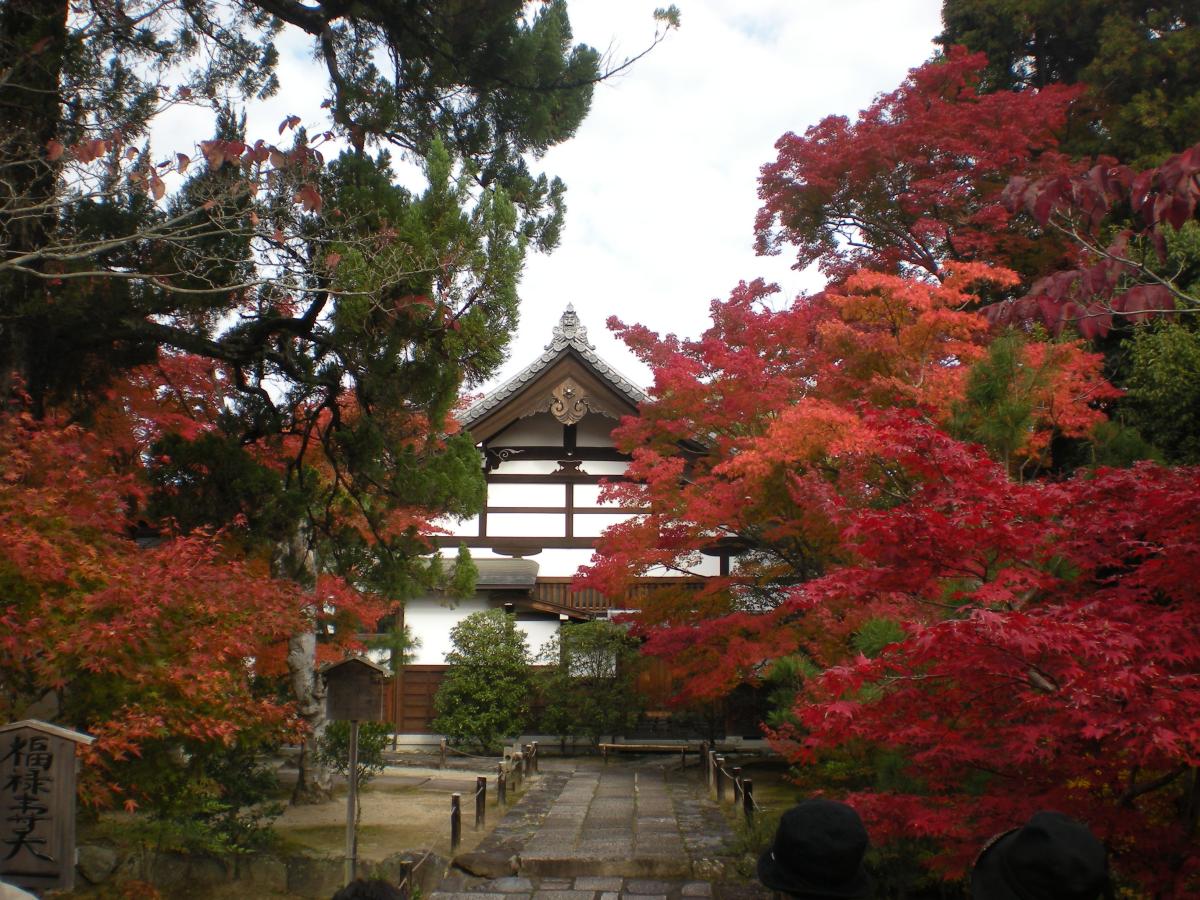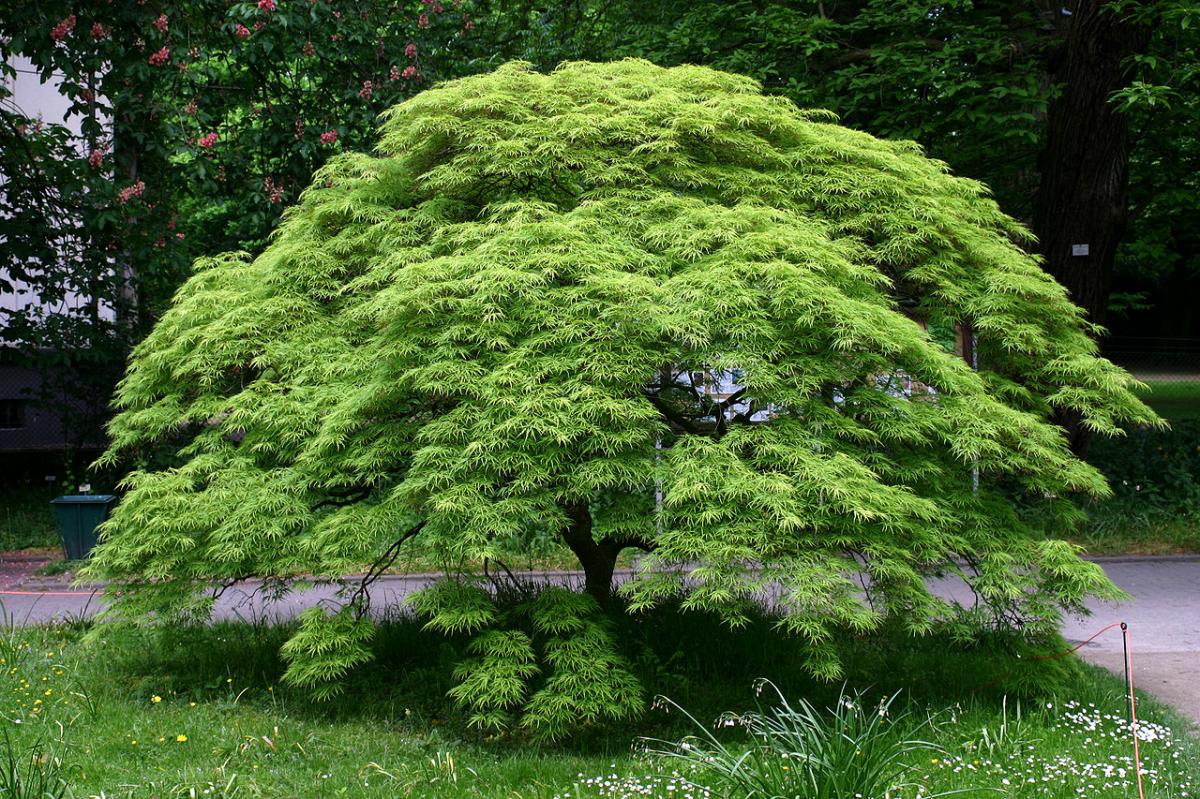
Image - Wikimedia / Joe Mabel
The Japanese maple is a plant that meets many characteristics to be adored by many people: the color of its leaves is spectacular during autumn (and also, depending on the variety, in spring), its bearing is very elegant, it resists pruning. (something you like to know when you have almost no space to put more pots), and also, it supports frosts of up to 18 degrees below zero wonderfully well.
We could say that, in reality, it has everything so that it can be cultivated anywhere in the world. But we would be wrong. This is a mountain tree or shrub, so when we wonder why my Japanese maple has brown or dry leaves, we have to find out what is the growing mistake we are making.
Things to know about Japanese maple

Knowing it a little, we can know how to take care of it. Therefore, before telling you the possible causes why your plant has brown or dry leaves, let me briefly explain what its needs are. And, yes, we have already said that their natural habitat is the mountains, specifically those of Japan, Korea and China. There the climate is seasonal, spring and summer being mild, and autumn and winter cold with frosts. In fact, the normal thing is that every year the landscape is covered with snow.
In addition, ambient humidity is high, not only because it rains frequently, but because they tend to grow near the coast. The islands of Japan, without going any further, are relatively small, so the humidity is always very high; and yet these plants grow into wonderful forests. The temperatures, which are only 'extreme' in winter, the rainfall and the humidity, make them not exactly the easiest plants to care for.
But there is still something else: the land. The vast majority of maple species thrive in light, fertile, acidic or slightly acidic soils. Our protagonist too. That is why they are not grown (or are not usually grown) in clay or alkaline soils, for example, because their roots would not be properly aerated, and also that they could not find the much-needed iron. Thus, in these conditions the leaves turn yellow, turn brown and finally fall. And of course, it does not matter.
Now, in certain climates (such as the Mediterranean) it is a very demanding species. But trust me when I tell you that it can be grown without too much trouble. I myself have a collection of about 15 specimens in the south of Mallorca, about 4-5km from the coast in a straight line.
Is it difficult to have them pretty? Yes. Impossible? Not at all (unless you want to have them in an area with a tropical climate, in which case it is impossible to have them well, since they need the seasons to be differentiated, and to freeze or snow in winter).
Why do the leaves of the Japanese maple turn brown?
There are several causes, so we are going to see them all separately:
Dry weather
Either because it is in a windy area and / or because the humidity is very low, the leaves of your Japanese maple can spoil almost overnight. Why? Because to keep these leaves hydrated, the roots must find and absorb water. For this, it is not only essential that it receives water, either from rain or irrigation, but it is also important that the soil is light, and that it does not have a tendency to compact.
What to do?
The first thing is, if you live in a place where the wind blows strongly, protect the plant. If you have it in a pot, simply take it to another place where it will be more protected. But if it's in the ground, consider planting large bushes or trees, or even a windbreak hedge.
If the environment is dry or very dry, you should spray (spray) its leaves with water in the afternoon. Use rainwater, or soft water. Soak the foliage well, on both sides. It doesn't matter if it ends up dripping. Your maple needs to hydrate.
The direct sun gives it
This is one of the most common causes, especially when grown in the Mediterranean. The degree of insolation can be so high that although the humidity is also high, it causes the leaves to lose resistance to the rays of the sun., even if they are cultivars that, elsewhere, may be in full sun (such as Acer palmatum »Seyriu», For example).
Also, keep in mind that the vast majority of Japanese maple varieties need shade or, at the very least, semi-shade for them to grow.
What to do?
The solution is simple: put it in the shade, or if it is planted on the ground, put something (shading mesh (on sale here), or plant large plants nearby for example) to protect you from the sun. In my case, I have them under a greenhouse-like structure that I made for them, protected with a shading mesh. They are in pots, yes:
Truth be told: it's not exactly the prettiest thing in the world, but as long as you keep the maples protected, all will be fine. (Although if you want it to be decorative, you can replace the shading mesh with a tent or gazebo, and incidentally use it to hold meetings with your loved ones).
Is drying up
It is not a plant that wants a lot of water, but it is necessary to control that it does not lack, since does not resist drought. If the leaves turn brown, starting with the young ones, you may need to water it more often. Also, if you grow it on substrates type akadama, pumice or similar, you have to know that these dry quickly, so watering must be frequent.
What to do?
The most important is check the soil moisture to make sure it is really short of water. To do this, you have to dig a little with your fingers, until reaching a depth of about 5 to 10 centimeters (if it is in a pot, less), being careful not to damage the roots. If you notice that it is cool and humid, you will not have to water. Another option is to insert a wooden stick: if you see that when you remove it, a lot of soil has adhered to it, then do not water.
But if on the contrary it is dry, take the watering can, fill it with water and give it a conscientious watering. Thereafter, the frequency of watering increases.
Has too much water
If, on the other hand, more water is added than it is capable of absorbing, their roots will puddle and die. It happens a lot when the soil does not drain the water well, and also, when it is grown in pots with poor quality substrates and / or without perlite, claystone or similar. Even if you have it in akadama, you have to check its condition every few years (2-3), since it is a clay, and as such, it falls apart.
Therefore, if you see that the soil is very wet, compact, and / or if the verdina is already beginning to appear on the soil, then you have to readjust the irrigation.
What to do?
In addition to checking the humidity of the soil and watering less, It is important that you see if said land is suitable. That is, if for example you have it in peat alone, you should mix it with perlite; if you have it in akadama, maybe it is a good time to renew it if it has already been discarded (get it here). Do it in late winter, so that it can get through the transplant.
In the event that it is summer, take it out of the pot and wrap the earth bread with absorbent paper. Don't touch the roots. Leave it in a dry place protected from the sun for about 24 hours. After that time, plant it again in a pot - better if it is new - and treat it with fungicide so that the fungi do not harm it.
Iron deficiency

Image - Wikimedia / Rüdiger Wölk
The lack of iron causes iron chlorosis, a problem that all acidic plants have that are watered with alkaline water and / or that grow in soils also with a high pH (7 or higher). Iron is important so that you can photosynthesize normally, that is, so that you can eat and be healthy. But how do you know if the japanese maple have chlorosis? Looking at its leaves: they will turn yellow, but the nerves will stay green. Later, they will dry up and fall off.
What to do?
To correct the problem you have to do several things. The most important is give the plant iron, so you must water it with iron chelate (for sale here). But also, you have to check the pH of both the soil and the irrigation water. This must be between 4 and 6. If either of the two is alkaline (pH greater than 7), you have to change it.
In the first case, you will have to plant it in pots with substrate for acidic plants (here you can get it) or coconut fiber (do not stay without him), and in the second acidify the irrigation water with lemon or vinegar.
Need fertilizer
This cause may or may not be related to the previous one. Japanese maples are big 'food' claimants, not in vain, they only grow in soils rich in organic matter. For this reason, when they are grown on substrates such as akadama, pumice, coconut fiber, ... in short, on poor substrates, they tend to have problems due to lack of fertilizer.
What to do?
From early spring to late summer you have to fertilize your plant with an acidic plant fertilizer. It is also advisable to fertilize it from time to time (in alternate months for example) with organic fertilizers, such as guano. Follow the instructions that you will find on the package so that you do not miss anything.
Running out of space (flower pots)
If you are growing your maple in a pot, and you are having it as a shrub or tree and not as a bonsai, you should go transplanting it every 3 years approximately. Lack of space will damage the plant, which will end up with brown leaves prematurely.
What to do?
When you suspect you need a bigger pot, transplant it in late winter, before it starts to remove leaves. Choose a container that is 5-10 centimeters larger in diameter and depth, and has holes in the base (such as this).
It is autumn

To the Japanese maple that has brown or dry leaves in autumn, it is normal that nothing is happening to it. Namely, it is a deciduous plant, which loses its foliage precisely in autumn / winterSo if your plant is turning brown this season, don't worry.
What's more, you have to know that if the weather is a little warmer than it needs to be, its leaves will not turn any pretty color, but will directly turn brown. For example, in the Mediterranean this happens a lot: as it is very hot in summer (35-40ºC maximum) and autumn temperatures are not very low either (they tend to touch 20-25ºC throughout the season), few deciduous trees ever grow pretty. I've only ever seen one Melia sourach with some yellow leaves, but not the whole tree.
Has it been useful to you? I hope you were able to find the solution to your Japanese maple problem.










